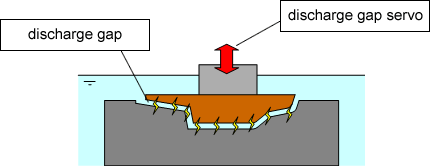8. Discharge gap
A proper "gap" is necessary to generate sparks between an electrode and a workpiece. This gap is called "discharge gap".
The lightning spark occurs at very long distances from the cloud to the ground, and the voltage reaches millions volts. In EDM, the voltage supplied is approximately 50 to 300 volts because higher voltage is not suitable for high precision machining. Therefore, EDM discharge gap is about 0.005 - 1.0mm.
Sparks do not occur in the condition that an electrode and work touch each other (i.e. discharge gap = 0), and the machining does not proceed. EDM moves an electrode up and down minutely depending on progress of the machining, and adjusts the electrode position to make the discharge gap suitable for sparking. This control which keeps the discharge gap proper is called "discharge gap servo".

